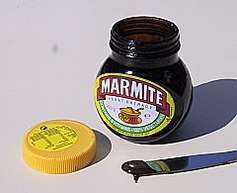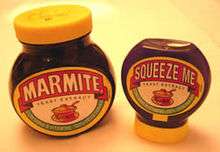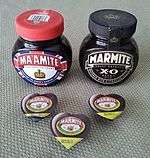Marmite
 A jar of Marmite | |
| Type |
Food brand |
|---|---|
| Inception | 1902 |
| Manufacturer | Marmite Food Extract Company |
| Current supplier | Unilever |
| Website |
https://www.unilever.co.uk/brands/our-brands/marmite.html, https://www.marmite.co.uk/ |
Marmite (/ˈmɑːrmaɪt/ MAR-myte) is a British food spread produced by Unilever. Marmite is made from yeast extract, a by-product of beer brewing. Other similar products include the Australian Vegemite, the Swiss Cenovis, and the German Vitam-R.
Marmite is a sticky, dark brown food paste with a distinctive, powerful flavour, which is extremely salty. This distinctive taste is reflected in the marketing slogan: "Love it or hate it." Such is its prominence in British popular culture that the product's name has entered British English as a metaphor for something that is an acquired taste or tends to polarise opinions.[1][2]
The image on the front of the jar shows a "marmite" (French: [maʁmit]), a French term for a large, covered earthenware or metal cooking pot. Marmite was originally supplied in earthenware pots, but since the 1920s has been sold in glass jars shaped like the French cooking pot.
A similar spread called Marmite has been manufactured in New Zealand since 1919. This is the only product sold as Marmite in Australasia and the Pacific, whereas elsewhere in the world the British version predominates.
History
The product that was to become Marmite was invented in the late 19th century when German scientist Justus von Liebig discovered that brewer's yeast could be concentrated, bottled and eaten.[3][4] In 1902 the Marmite Food Extract Company was formed in Burton upon Trent, Staffordshire, England with Marmite as its main product and Burton as the site of the first factory.[5] The by-product yeast needed for the paste was supplied by Bass Brewery. By 1907, the product had become successful enough to warrant construction of a second factory at Camberwell Green in London.[6]
By 1912, the discovery of vitamins was a boost for Marmite, as the spread is a rich source of the vitamin B complex; with the vitamin B1 deficiency beri-beri being common during World War I, the spread became more popular.[7] British troops during World War I were issued Marmite as part of their rations.[3]
In the 1930s, Marmite was used by the English scientist Lucy Wills to successfully treat a form of anaemia in mill workers in Bombay. She later identified folic acid as the active ingredient.[8] Marmite was used to treat malnutrition in Suriya-Mal workers during the 1934–5 malaria epidemic in Sri Lanka.[9] Housewives were encouraged to spread Marmite thinly and to "use it sparingly just now" because of limited rations of the product.
In 1990, Marmite Limited, which had become a subsidiary of Bovril Limited, was bought by CPC International Inc, which changed its name to Best Foods Inc in 1998. Best Foods Inc subsequently merged with Unilever in 2000, and Marmite is now a trademark owned by Unilever.[10].
Similar products
There are a number of similar yeast products available in other countries; these products are not directly connected to the original Marmite recipe and brand. The Australian product Vegemite is distributed in many countries, and AussieMite is sold in Australia. Other products include OzeMite, which is made by Dick Smith Foods; Cenovis, a Swiss spread; and Vegex, an autolyzed yeast product available in the United States since 1913.[11]
Usage
Marmite is traditionally eaten as a savoury spread on bread, toast, savoury biscuits or crackers, and other similar baked products. Owing to its concentrated taste it is often spread thinly with butter or margarine.[12] Marmite can also be made into a savoury hot drink by adding one teaspoon to a mug of hot water much like Oxo and Bovril.
Marmite is paired with cheese, such as in a cheese sandwich, and has been used as a flavour variety of Mini Cheddars, a cheese-flavoured biscuit snack. Similarly, it is one of Walkers Crisps flavours; is sold as a flavouring on rice cakes; and Marmite Biscuits. Starbucks in the UK has a cheese and Marmite panini on its menu.[13]
Marmite has been used as an ingredient in cocktails, including the Marmite Cocktail and the Marmite Gold Rush.[14][15][16]
Manufacture
While the process is secret, the general method for making yeast extract on a commercial scale is to add salt to a suspension of yeast, making the solution hypertonic, which leads to the cells shrivelling up; this triggers "autolysis", in which the yeast self-destructs. The dying yeast cells are then heated to complete their breakdown, and since yeast cells have thick cell walls which would detract from the smoothness of the end product, the husks are sieved out. As with other yeast extracts, Marmite contains free glutamic acids, which are analogous to monosodium glutamate.
Today, the main ingredients of Marmite are glutamic acid-rich yeast extract, with lesser quantities of sodium chloride, vegetable extract, spice extracts and celery extracts, although the precise composition is a trade secret.[17] Vitamin B12 is not naturally found in yeast extract, but is added to Marmite during manufacture.[18]
Nutritional information
Marmite is rich in B vitamins including thiamin (B1), riboflavin (B2), niacin (B3), folic acid (B9) and vitamin B12. The sodium content of the spread is high and has caused concern, although it is the amount per serving rather than the percentage in bulk Marmite that is relevant. The main ingredient of Marmite is yeast extract, which contains a high concentration of glutamic acid. Marmite is almost gluten free.[19] However, Unilever will not confirm that it contains less than 20 ppm of gluten, the current European standard and the proposed US FDA standard for gluten-free labelling.
Marmite should be avoided if a person takes a MAOI antidepressant, such as phenelzine (Nardil) or tranylcypromine (Parnate), as yeast extracts interact adversely with these types of medications due to their tyramine content.[20]
Marmite today is fortified with added vitamins, resulting in it being banned temporarily in Denmark, which disallows foodstuffs that have been fortified until they have undergone necessary testing.[21] The Danish Veterinary and Food Administration stated in 2015 that Marmite had not been banned in the country, but that fortified foods need to be tested for safety and approved before they can be marketed in the country.[22] In 2014, suppliers applied for a risk assessment to be undertaken after which Marmite became available in Denmark.[23][24]
| per 100 g | per 4 g serving | ||
|---|---|---|---|
| Energy | 983 kJ | 39 kJ | |
| Calories | 231 kcal | 9 kcal | |
| Protein | 38.4 g | 1.5 g | |
| Carbohydrates | 19.2 g | 0.8 g | |
| of which sugars | 0.5 g | trace | |
| Fat | 0.1 g | nil | |
| of which saturates | trace | nil | |
| Fibre | 3.1 g | 0.1 g | |
| Sodium | 3.9 g | 0.2 g | |
| Salt | 11 g | 0.44 g | |
| % RDA | |||
| Thiamin (B1) | 5.8 mg | 0.23 mg | 17% |
| Riboflavin (B2) | 7.0 mg | 0.28 mg | 18% |
| Niacin (B3) | 160.0 mg | 6.4 mg | 36% |
| Folic Acid | 2500 µg | 100 µg | 50% |
| Vitamin B12 | 15.0 µg | 0.6 µg | [26] 40% |
|
RDA = Recommended Daily Allowance | |||
Marketing and packaging

Marmite's publicity campaigns initially emphasised the spread's healthy nature, extolling it as "The growing up spread you never grow out of." The first major Marmite advertising campaign began in the 1930s, with characters whose faces incorporated the word "good". Soon afterwards, the rising awareness of vitamins was used in Marmite advertising, with slogans proclaiming that "A small quantity added to the daily diet will ensure you and your family are taking sufficient vitamin B to keep nerves, brain, and digestion in proper working order."
During the 1980s, the spread was advertised with the slogan "My mate, Marmite", chanted in television commercials by an army platoon. The spread had been a standard vitamin supplement for British-based German POWs during the Second World War.
By the 1990s Marmite's distinctive and powerful flavour had earned it as many detractors as it had fans, and it was known for producing a polarised "love/hate" reaction amongst consumers. For many years TV adverts for Marmite featured the song Low Rider by War with the lyrics changed to the phrase "My Mate, Marmite". Marmite launched a "Love it or Hate it" campaign in October 1996, and this resulted in the coining of the phrase "Marmite effect" or "Marmite reaction" for anything which provoked strong and polarised feelings.[27] On 22 April 2010, Unilever threatened legal action against the British National Party for using a jar of Marmite and the "love it or hate it" slogan in their television adverts.[28]
Availability worldwide
Because of the local product, British Marmite is sold under the name "Our Mate" in Australia and New Zealand. New Zealand Marmite uses the name "NZ-Mite" elsewhere.
In Denmark, food safety legislation dictates that foodstuffs that contain added vitamins can only be sold by retailers which have been licensed by the Veterinary and Food Administration.[29] In May 2011, the company that imports the product to Denmark revealed that it wasn't licensed and had therefore stopped selling the product: this led to widespread but inaccurate reports in the British media that Marmite had been banned by the Danish authorities.[30][31][32]
Canada
On 24 January 2014, the Canadian Food Inspection Agency was noted, in a CBC story, as moving to stop the sale of Marmite, as well as Vegemite and Ovaltine, in Canada because they were enriched with vitamins and minerals which were not listed in Canadian food regulations. The agency said the products were not a health hazard.[33] The CFIA later clarified that these specific items had been seized because they were not the versions that are formulated for sale in Canada and which met all Canadian food regulations. Canadian versions of Marmite and the other products would still be permitted to be sold in Canada.[34]
South Africa
Marmite is manufactured under licence in South Africa by Pioneer Foods in traditional and cheese flavour.
Special editions

In 2002 a 100th anniversary jar was released.
In February 2007 Marmite produced a limited edition Guinness Marmite of 300,000 250g jars of their yeast extract with 30% Guinness yeast, giving it a noticeable hint of "Guinness" flavour. In January 2008 Champagne Marmite was released for Valentine's Day,[35] with a limited-edition run of 600,000 units initially released exclusively to Selfridges of London. The product had 0.3% champagne added to the recipe, and a modified heart-shaped label with "I love you" in place of the logo.
In 2009, a limited edition Marston's Pedigree Marmite was launched to celebrate the 2009 Ashes Cricket test series.[36]
In March 2010, a super-strong blend called Marmite Extra Old, or XO for short, was launched in the UK. Normal Marmite contains a mix of lager, bitter and ale varieties of yeast, sourced from breweries throughout the UK. However, as lagers have a lighter, sweeter taste, residue from this product is not used in Marmite XO. Only residue from traditional bitters and ales are blended to ensure the stronger taste. Marmite XO is matured for 28 days - four times longer than usual. Continuing the tradition of different coloured caps for special editions, Marmite XO's cap is black.
In April 2012 a special edition jar in commemoration of the Diamond Jubilee of Queen Elizabeth II was released. With the product renamed "Ma'amite," the redesigned label featured a colour scheme based upon the Union Jack; the marmite and spoon logo replaced by a gold crown, and with a red rather than yellow cap.[37] The front label also declares "Made with 100% British Yeast". Coinciding with the 110th anniversary of the brand, production was limited to 300,000 jars.[38] For Christmas 2012 a gold limited edition was launched, containing edible gold-coloured flecks.
Marmite chocolate is also available.[39]
In 2015, Marmite Summer of Love Special Edition featured a flower power themed label. This special edition's blend had a lighter taste made using 100% Lager yeast.[40]
See also
References
- ↑ Hodsdon, Amelia (22 April 2010). "How Marmite spread its way through journalism". The Guardian. Retrieved 26 June 2014.
- ↑ Gabbatt, Adam (13 October 2016). "Marmite: Americans wonder what's all the fuss over divisive British spread?". The Guardian. Retrieved 16 March 2017.
- 1 2 "Marmite: Ten things you'll love/hate to know". BBC News. 25 May 2011.
- ↑ "A brief history of Marmite". ihatemarmite.com. Retrieved 26 August 2016.
- ↑ "Marmite Food Extract Co". Grace's Guide. Retrieved 15 July 2014.
- ↑ "The Marmite Story". Accomodata.co.uk. Retrieved 21 June 2009.
- ↑ "Food brands: Marmite". Unilever. Archived from the original on 13 March 2010. Retrieved 13 March 2010.
- ↑ Bastian, Hilda (2007). "Lucy Wills (1888–1964): The life and research of an adventurous independent woman". The James Lind Library. Archived from the original on 8 December 2008. Retrieved 21 June 2009.
- ↑ Lerski, George Jan (1968). "Chapter I: The Party of Protest is Launched". Origins of Trotskyism in Ceylon: A Documentary History of the Lanka Sama Samaja Party, 1935-1942. Stanford, California: The Hoover Institution, Stanford University. Retrieved 29 November 2008 – via Marxists.org.
The two things given to each patient were a bottle of the standard quinine mixture and Marmite rolled into the form of vederala's pills. The latter was said to have been the idea of the late Dr. Mary Ratnam and to have been more effective than the quinine itself, such was the degree of starvation among the peasantry. The Suriya Mal workers were amazed to see how this little Marmite revived them and put some life back into them.
- ↑ "Trade Mark 2333143". Intellectual Property Office (UK). Retrieved 3 June 2012.
- ↑ "Vegex". Center for Educational Advancement. 21 June 2010. Archived from the original on 1 April 2011. Retrieved 5 July 2011.
- ↑ Barton, Laura (4 January 2002). "It must be spread thinly. T-h-i-n-l-y..." The Guardian. Retrieved 18 February 2014.
- ↑ "Cheese and Marmite panini". Starbucks.co.uk. Retrieved 5 March 2012.
- ↑ "DIY: The Marmite Cocktail". Difford's Guide. 5 November 2012. Retrieved 20 September 2014.
- ↑ "Marmite Cocktail Gold Rush". Langham Hotels. 20 September 2014. Retrieved 20 September 2014.
- ↑ Murphy, Patricia (4 May 2014). "Salty Savoury: The new trend in cocktails?". Irish Independent. Retrieved 23 February 2015.
- ↑ "Marmite ingredients (company web site)". Marmite.co.uk. Archived from the original on 23 July 2008. Retrieved 21 June 2009.
- ↑ "The vegan diet - Live Well". NHS Choices. Retrieved 4 April 2017.
- ↑ "Yeast extract update". Coeliac UK. Retrieved 2018-10-12.
- ↑ Hall-Flavin, Daniel K. (19 January 2016). "Depression (major depressive disorder)". Mayo Clinic. Retrieved 1 September 2016.
- ↑ Heppenstall, Jason (24 May 2011). "Spread no more: Denmark bans Marmite". The Guardian. Retrieved 16 December 2013.
- ↑ "Marmite not banned in Denmark". Danish Veterinary and Food Administration. Retrieved 14 January 2016.
- ↑ "Vikings defeated! Marmite back on Danish shelves". The Copenhagen Post (in Danish). 22 August 2014. Retrieved 14 January 2016.
- ↑ "Denmark ready to love Marmite again after ban is overturned". MailOnline. 22 August 2014. Retrieved 14 January 2016.
- ↑ "Nutrition". Marmite.co.uk. Archived from the original on 23 July 2008. Retrieved 27 November 2008.
- ↑ "Based on RDA of 1.5µg". Eat Well.gov.uk. Archived from the original on 10 October 2010.
- ↑ Cath Kidston, appearing on BBC Radio 4's Desert Island Discs programme in April 2010 described her shops as provoking a 'Marmite reaction': "People either love it and want a little bit of it very much, or want to stab us." "Desert Island Discs: Cath Kidston". BBC. 29 April 2010. Retrieved 29 April 2011.
- ↑ "BNP facing Marmite legal action". BBC News. 22 April 2010. Retrieved 22 April 2010.
- ↑ "Marmite: Ten things you'll love/hate to know". BBC News. 25 May 2011.
- ↑ Heppenstall, Jason (24 May 2011). "Spread no more: Denmark bans Marmite". The Guardian.
- ↑ "They definitely hate it! Denmark BANS Marmite... because it has too many vitamins". Mail Online. 25 May 2011.
- ↑ Waterfield, Bruno (25 May 2011). "Marmite made illegal in Denmark". The Daily Telegraph.
- ↑ "Ottawa shoppers stocking up on banned British, Scottish items". CBC News. 24 January 2014. Retrieved 25 January 2014.
- ↑ "Seizure of British foods an isolated incident, CFIA says". CBC News. 26 January 2014. Retrieved 6 February 2014.
- ↑ "Limited Edition Champagne Marmite". The Foodielist. 11 January 2008. Retrieved 26 May 2010.
- ↑ Wallop, Harry (1 June 2009). "Marmite limited-edition 'cricket spread' to celebrate Ashes". The Daily Telegraph. London. Retrieved 21 June 2009.
- ↑ "Marmite: Ma'amite – Print (image)". Creativity Online. 23 April 2012. Retrieved 12 July 2012.
- ↑ "Blog : Jubilee Marmite – Ma'amite – already for sale on eBay". Tamebay. Retrieved 12 July 2012.
- ↑ "Marmite Very Peculiar Milk Chocolate". Chocablog.com. Retrieved 26 August 2016.
- ↑ "2015 Summer of Love". Marmite.co.uk. Retrieved 15 November 2016.
External links
| Wikimedia Commons has media related to Marmite. |